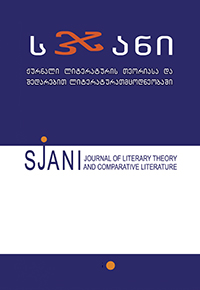ტიპოლოგიური პარალელები (VIII-X საუკუნეების ქრისტიანული პოეზიის ისტორიიდან)
Typological Parallels
(Towards the History of Christian Poetry from the 8th to 10th Century)
Author(s): Lela KhachidzeSubject(s): Literary Texts
Published by: ლიტერატურის ინსტიტუტის გამომცემლობა
Keywords: Andrew Pyrrhus; hymnography; stichera.
Summary/Abstract: Among “forgotten” authors of the fi rst period of Byzantine Christian poetry the personality of Andrew Pyrrhus “shrouded in mystery” attracts special attention. He was a contemporary of the reformers of Byzantine hymnography – John Damascus and Kosmas of Jerusalem and shared their ideas. The period of Andrew Pyrrhus’s creative activity must be referred to the 8th century. To him belong 85 small-sized hymns created for the “Triodion”, all of which are the “Automela”. The hymns by Andrew Pyrrhus are designed for the long period of Lent – from the Apokreos Sunday up to the Palm Friday. These hymns are considered to be the masterpiece of the Byzantine hymnography. For each day of Lent Andrew Pyrrhus created two small-sized hymns that reflect traditions of the Jerusalemite period. From preparatory period of the Lent he recognizes only the Week of Apokreos. In this case he also follows Jerusalemite tradition because the weeks preceding Lent known as: Sunday of the Publican and Pharisee as well as Sunday of the Prodigal Son germinated in Constantinople and they are not known to Jerusalemite practice. Andrew Pyrrhus knows very well the creative works of his ancestors, namely Andrea of Crete. On his part, he had an impact on the creations of Byzantine hymnologists of the 8th-9th centuries. According to John Mercuropulos who wrote “The Life” of John Damascus and Kosmas of Jerusalem the whole cycle of stichera intended for the Lent belongs to Kosmas of Jerusalem and it was his fi rst composition. In contrast to this the collections of small-sized hymns preserved in Greek recognize in one voice Andrew Pyrrhus to be an author of this cycle. In Western and Slavonic “Triodions” Andrew Pyrrhus’s hymns are often inscribed as “agiapolitou”or “Oriental”. For the research into Andrew Pyrrhus’s creative activity extremely interesting material is preserved in ancient Georgian manuscripts which bear a number of inscriptions of Andrew’s name on the hymns. This is a unique material as yet unknown to the scholars. In Georgian manuscripts small-sized hymns with the inscription “Anatolian” are also evidenced. Similar case can be found in the history of Georgian hymnography. Great Georgian hymnologist of the 10th century Ioanne Minchkhi created a whole cycle of small-sized hymns for each day of Lent – 88 stichera that produces one of the most important components of Lent liturgy. For each day of Lent usually 2 – 2 stichera are composed and for the weeks of Lent and especially important holidays more than 2 of Minchkhi’s sticheras are added. Ioane Minchkhi also wrote the hymns for the whole Lent period – from Apokreos Sunday including the Great Saturday. These hymns represent the best specimens of the hymnography and define the level and opportunities of the original Georgian hymnography in a new way.
Journal: სჯანი
- Issue Year: 2011
- Issue No: 12
- Page Range: 135-141
- Page Count: 6
- Language: Georgian

